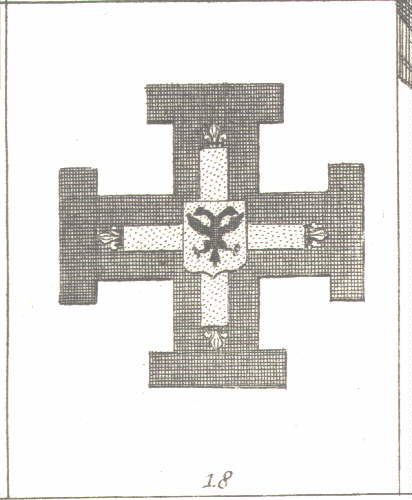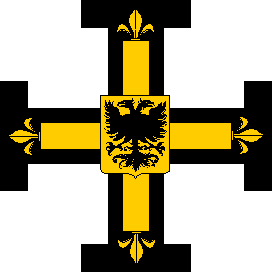
See a much more ddetailed account on the Chivalric Orders web site.
The Teutonic Order was founded in 1190 during the siege of Acre, when a hospital brotherhood was established to care for the many sick German crusaders. It was given a building after the conquest of the city, and in 1198 was turned into a military-monastic order on the model of the Hospitallers of Saint John and the Templars. This creation reflected the growing involvement of the Hohenstaufen dynasty in the Holy Land.
From the start, the order started a policy of conquering land and building up independent territory: in the Holy Land, in Hungary in 1211-25, and later in Prussia, after it absorbed the Sword-Brethren in Livonia. It was in Prussia that the order fought with the Polish dukes of Masovia and Silesia to subjugate the pagan Prussians and fight against Novgorod. After the fall of Acre in 1291 the Grand Master went to Venice, and, following the conquest of Pomerelia in 1309, to Marienburg in Prussia. Thus the Order, by now exclusively nobiliary, came to form an independent political entity. In 1243, Pope Innocent IV had placed the Order's possessions in the Pope's domain, but in practice the Order was completely independent. Its fortunes began to fade in 1410 with the defeat inflicted at Tannenberg by Poland-Lithuania, and a revolt in its territories in 1454-66 further diminished it and it became a vassal of Poland.
The Reformation brought many changes to the Order. In 1525, the Hochmeister Albrecht of Brandenburg-Anspach secularized the Order's Prussian holdings into the duchy of Prussia, resigned from the order, became Lutheran, and gav ehomage for the duchy to the king of Poland on April 10, 1525. In Livonia, the Ordenmeister Livlands Gotthard von Ketteler did the same in 1561 and turned the remnants of the order's estates (most of which had been divided between Sweden and Poland) into the duchy of Kurland. In the German Empire, the Deutschmeister became Grand Master in 1530 and the seat of the Order transferred from Marienburg to Mergentheim; the order survived in Germany, adapting to local politics. The protection of the Habsburg dynasty (which reformed the order in 1606) proved a mixed blessing: the order survived, but it never regained any independence, and its efforts were redirected in the Habsburgs' wars against the Turks. With the treaty of Westphalia in 1648 Catholic, Lutheran and Calvinist knights received equal rights within an order headed since the late 16th century by a Habsburg Grand Master. Some bailliwicks like Elsass, Burgund, Koblenz, Österreich, Bozen remained Catholic, others like Thüringen, Sachsen were Protestant, and Hessen was tripartite (Catholic, Lutheran, Calvinist). In 1637 the (Protestant) Dutch knights broke away and formed the Ridderlijke Duitsche Orde, Ballij van Utrecht, which still exists. In 1809 the order was expelled from most German states, and survived only in Austria. Reduced to four knights in 1839, it was reorganized by the Austrian emperor as a Catholic charitable institution. Nuns were introduced (they had existed in the medieval Order). Knights of honor (1866) and Marianer (1871) were created to attract financial support, while the knights themselves were essentially noble Austrian officers.
With World War I and the end of the Habsburg monarchy the order lost its last possessions. In 1923 archduke Eugen resigned as Grand Master; in 1929 the Pope reorganized the order as a purely religious order of priests. No more knights were created and the last one (Friedrich Graf Belrupt-Tissac) died in 1970. The order suffered during World War II when it was abolished by the Nazis in Austria and Czechoslovakia, but it survived in Italy and started again after 1945 in Austria and Germany.
In its current form, the order has 87 brethren, 294 sisters, 12 honorary knights and 613 Marianer or associates. The Hochmeister resides in Vienna.
The arms of the Order were originally Argent a cross sable. The emblem of the Order was a cross potent sable, thereon a cross flory or, thereon an escutcheon of the Empire. The cross sable was supposedly granted by the Emperor Henry VI, the cross or by the king of Jerusalem John, the fleurs-de-lys by Louis IX of France, and the escutcheon by Frederic II Hohenstaufen.

Insignia of the Teutonic Order, from Diderot's Encyclopédie

Insignia of the Teutonic Order, by Arnaud Bunel
Originally, the Hochmeister quartered his arms with those of the order, as did occasionally the Deutschmeister and the Baillif of Brandenburg. The high officers, baillifs, preceptors and commanders added the chief of the order to their arms.
Historical source: Udo Arnold, Eight Hundred Years of the Teutonic Order, in Malcolm Barder: The Military Orders: Fighting for the Faith and Caring for the Sick, Variorum, Aldershot (UK), 1994. A great book is:800 Jahre Deutscher Orden : Ausstellung des Germanischen Nationalmuseums Nurnberg in Zusammenarbeit mit der Internationalen Historischen Kommission zur Erforschung des Deutschen Ordens (edited by Udo Arnold with the collaboration of Irmtraud Frfr. von Andrian-Werburg, Ronny Kabus, Andrea M. Kluxen; Gutersloh : Bertelsmann Lexikon Verlag, 1990.